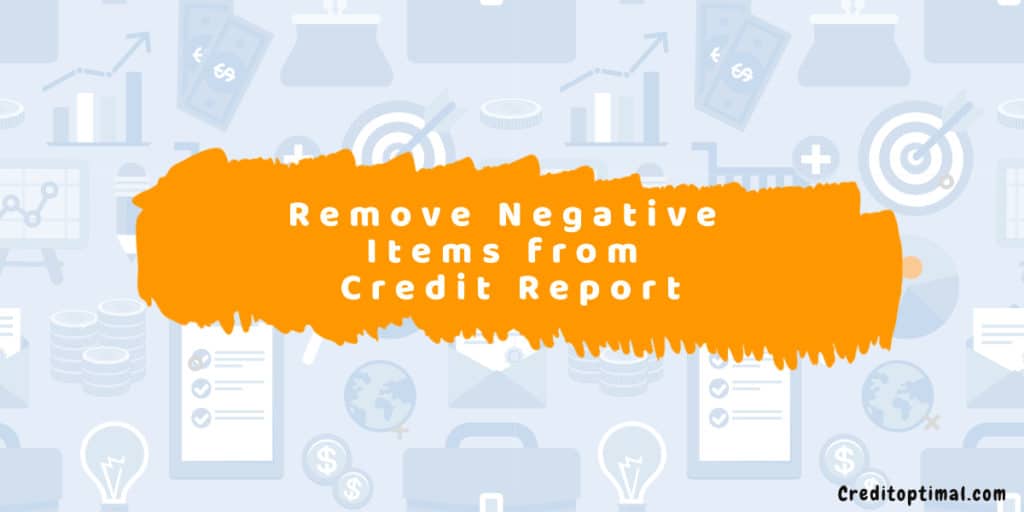Negative things are enormous reminders of the financial mistakes you made in the past.
In some cases, however, the mistake could not be yours, but a creditor or credit bureau is to blame for the errors.
Either way, you must work towards removing the negative items from your report to avoid unfavorable credit eventualities.
Deleted negative items would help you achieve a higher credit score, which improves your chances of getting good credit card loans and fair interest rates.
Luckily, it is possible to delete negative items by using any of the three options below:
- Writing a “goodwill” adjustment.
- Paying to have the negative item deleted
- Offering a settlement
Whether you made the late payment or the lender’s mistake, here’s how to go about it.
Check for mistakes
Legally, creditors are obligated to remove any mistakes on your credit report, which were captured inaccurately.
Studies have shown that most people have incorrect items in their credit reports, and the trick here is to look for any mistakes whatsoever on each entry.
After pulling your reports from the three credit bureaus – Experian, TransUnion, and Equifax – look at each of the entries carefully to override the likelihood of the following items:
- Account status
- Credit limit
- High balance
- Account number
- Account balance
- Date opened
- Payment status
Whenever you find an error, mark it along with its counterpart, and then go ahead with working on their removal.
For clarity, ask for well-written documentation of any negative remarks and request to have them removed.
Period through which negative items drop
Several negative items on your credit report will fall off after the expiry date, which varies depending on the type of item.
- Missed payment: 7 years
- Repossession or foreclosure: 7 years
- Bankruptcy: 7 years (chapter 13) or ten years (chapter 7)
- Account charged-off or sent to collections: 7 years
- Civil judgments: 7 years
- Repossessions: 7 years
Once you’ve identified a negative item(s), check for things like inaccurate account balance, a mistake in your account number, or incorrect dates, which could partly invalidate the negative item.
Remember that the idea here is to pile the burden of proof to the creditors by providing evidence that the information on their databases is incorrect.
If you find a mistake, ask the credit information centers to verify the entry – which they would within 30 days according to the law.
While this can sound like an incredibly hard task, it can work if you keep doing it persistently, keeping in mind that if the late payment is several years old, the credit bureaus might not sufficiently source accurate information about it.
Filing a dispute with the credit bureaus
The (FCRA) dictates what form of information held on your credit report and for the longevity of time through which the information should stay there.
As a customer, you have every right to have accurate information and, for this reason, you can file a dispute should you find any disparities.
Such disputes are straightforward when made via mail or online. You must have requested your report form the reporting agencies, after which you can write a letter describing your issue and attaching copies as proof of your claims.
The credit information center will evaluate the dispute against the records of the business that provided the information after which they remove the entry if indeed it was wrong.
Negotiate with the credit providers
If you have legitimate negative items on your credit report, keep in mind that the negative things can fall seven years after your first delinquency.
The position you’re in – asking the lender to remove information from your credit report beyond their legal jurisdiction – requires utmost politeness and patience. Such values would go much further than entitlement and making demands.
Look at your credit report and see whom the delinquency belongs to so you accurately know which organization to contact. Don’t assume anything until you have every information since the original creditor might have actioned your collateral or sold you debt to a debt collection company.
If the debt hasn’t fully been paid, you can ask for a “pay for deletion” that requires you to negotiate an amount with the creditor in exchange for a deletion of the negative item.
If the loan has already been cleared, you can ask for a “goodwill adjustment.” This document is a typed letter or email, highlighting the positive steps you’ve taken to improve your credit score and a detailed explanation of why you think it would never happen in the future.
Offering a settlement
Reach out to the lender or bank if you have an unpaid loan on your report.
Explain that you’re offering to settle in exchange for its deletion with utmost clarity – preferably through a written letter or certified mail.
If you make this request to the credit bureau, they’ll inform you they can’t – and the only way to make this deletion is requesting the credit bureau.
One of the best strategies is offering a colossal amount for a single payment, which makes it appealing to them since they’ll get all the money at once and lightens the burden for you.
Keep in mind that they could be willing to accept a portion of the balance, rather than the whole amount, so you can start with a small offer as you scale the bid upwards.
If the deal means getting their money back, they’d instead negotiate with you rather than charge off your account or sell it to a collection agency, and if the creditor accepts the settlement deal, don’t get elated yet.
In some cases, they might refuse to delete the negative item entirely. Still, they could mark your account as “paid as agreed,” which lets future creditors (as much as the negative item still shows) understand that you completed the payment than letting it go.
Requesting a “pay for delete”
You should approach the removal of accurate negative items on your report differently since credit bureaus would not delete correct delinquencies from your credit report even if you raise a dispute.
Since the investigation would term these items as accurate, you can offer a “pay for delete” to have some (not all) negative items removed.
This methodology is best suited for defaulted accounts: you pay to have the delinquencies eliminated from your account.
The letter explicitly states that you’re offering to pay for a portion of all debt in exchange for deletion of the negative item.
While the creditor can delete it, you can use this strategy with credit collection agencies – which will only remove the collection accounts and not the original debt.
The collection agency is an entirely separate entity from the creditor. It would be best if you kept in mind that the original amount and the missed payment information could still appear on your credit report.
Making a “goodwill adjustment”
Using this approach requires you to use money as a bargaining chip for removing the negative items on your report. If you’ve already cleared the account’s payment, you won’t have much negotiating-power, at which point your request a “goodwill deletion.”
Essentially, this approach entails admitting and accepting your defaulted mistakes and asking the lender to remove the negative item one at a time.
This approach isn’t a guarantee to work for every occasion, and it’s perfect for some occasional financial slip rather than a massive list of financial mistakes.
If you, for instance, have a good repayment history, and you make a late payment because you were late on vacation, a goodwill adjustment could work perfectly here.
Remember that as much as you’re admitting guilt of making a late payment, the reporting agencies are obligated to provide accurate information and wouldn’t necessarily go along with the request.
Waiting out
If everything else turns out unsuccessful, the only option you might be having is waiting for seven years for the negative item to drop.
Legally, it takes up to 7 years for the negative item to be removed. This time frame excludes bankruptcy, which can last up to a decade.
The wait might not last as long it seems since your credit score improves as time goes by.
However, it is imperative to understand that the deleted information from your file might still be released in some circumstances – like applying for a job that pays above some amount or applying for a life insurance policy.
Final thoughts – Remove Negative Items from Credit Report
Negative items could affect your credit score and in turn impact the quality of loans and affordability of interest rates you’ll get.
The longer the items stay in your report, the higher the likelihood of the same affecting your ability to get favorable interest rates and credit card loans.
While you can use the highlighted ways to delete negative items, it is essential to note that filing bankruptcy, closing an account, or completing a delinquent payment won’t eliminate the negative elements.
Overall, the best way to avoid such occurrences is to maintain a good payment history, observe financial discipline and making payments on time!


